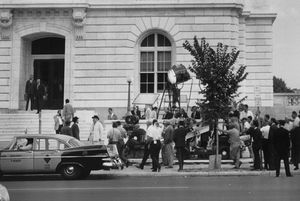
In the fall of 1961, two worlds collided when a Hollywood film crew arrived at the U.S. Capitol to film Advise and Consent, a movie based on Washington correspondent Allen Drury’s Pulitzer Prize-winning novel about a bitter Senate confirmation battle. Director Otto Preminger brought to the Hill an all-star cast, a crew of more than 150 people, and a lot of commotion. "There's more excitement on Capitol Hill about the soon-to-be filming of 'Advise and Consent' . . . than about the long anticipated adjournment [of Congress]," the Washington Post reported. "Nearly everyone . . . on Capitol Hill is getting into the picture one way or another.”1
The star-studded cast included Franchot Tone as the president, Lew Ayres as the vice president, Henry Fonda as the controversial secretary of state nominee (whose character lied about a youthful flirtation with communism), Walter Pidgeon as the Senate majority leader, and Charles Laughton as the president pro tempore, with other roles portrayed by Peter Lawford, Burgess Meredith, Gene Tierney, and George Grizzard. Adding to the public intrigue, and much speculation in Washington, was the fact that some of the characters in Drury's novel were based on real-life politicians. Grizzard’s character, for example, was loosely based upon Senator Joseph McCarthy of Wisconsin. Actress Betty White made her feature film debut playing the film’s only female senator, a character based upon Maine’s Margaret Chase Smith.2
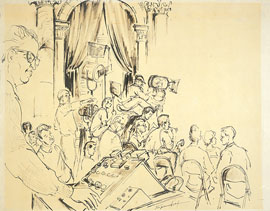
When Preminger and his film crew arrived on Capitol Hill, Washington socialites, Capitol Hill staff, members of the press, and even senators quickly found themselves a part of the action both on and off camera. “Scores of Senators' secretaries have been signed up to play themselves in the film and can hardly wait for the Senate to adjourn so they can begin their movie career,” noted one reporter. Preminger hired hundreds of extras, including socially prominent Washingtonians, to stage a key party scene filmed at the palatial Washington estate Tregaron. Members of the Washington press corps were hired to recreate the annual White House Correspondents Dinner at the Sheraton-Park Hotel. Former senator Guy Gillette of Iowa landed a role as a fictional senator, as did Arizona’s former senator, 87-year-old Henry Ashurst, who was cast as an elderly senator with a habit of dozing off during proceedings. Washington senator Henry "Scoop" Jackson played himself in the party scene.3
To ensure authenticity, the filmmakers brought in Allen Drury as technical advisor and consulted other experts, including Senate staff. Ruth Young Watt, chief clerk of the Senate's Permanent Subcommittee on Investigations, recalled in an oral history interview being asked to come in on a Saturday morning to advise the movie crew on setting up the large Caucus Room in the Old Senate Office Building (now called the Russell Senate Office Building) for a hearing. When she arrived, she was informed that they planned to have her in the scene as a clerk working at the nomination hearing, but she declined. The film’s director instead cast her colleague Gladys Montier in the role.4
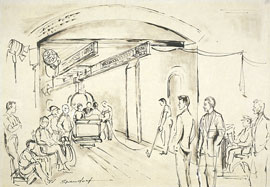
Preminger was permitted unprecedented access to many spaces throughout the Capitol complex. Filming took place in the Senate Press Gallery, the Capitol corridors outside the gallery of the Senate Chamber, the old Senate subway, and inside the Old Senate Office Building. Remaining off limits, however, was the Senate’s Chamber. A long-standing Senate rule prohibited filming in that historic space. Fortunately, Preminger had a remarkably accurate replica at his disposal. Back in the 1930s, when director Frank Capra was similarly denied permission to film Mr. Smith Goes to Washington in the Senate Chamber, he constructed an impressive reproduction on a Hollywood sound stage. Preminger brought Capra's old set out of storage, updated it to reflect the modern Chamber, and used the Hollywood set to shoot all Chamber scenes.5
While many on Capitol Hill were star-struck and enthusiastic about the making of the film, there were others who complained about the chaotic atmosphere. As cameras and equipment blocked streets and crowded the corridors of the Old Senate Office Building, senators, staff, and reporters found it difficult to go about their daily business. "In comes a company, lock, stock, and booms,” one person complained, “invading the Capitol and acting for all as though this exalted ground is merely another prop on sound stage seven.”6
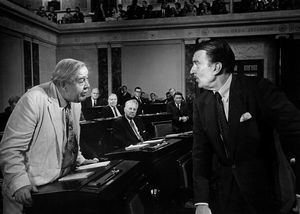
As filming continued, events around town brought together Hollywood and Washington celebrities. At a cocktail party in the Senate Caucus Room, actor Charles Laughton chatted enthusiastically with Mississippi senator John Stennis, whose voice he had been studying for his role as a southern senator. "It's getting hard to tell a senator from an actor—and vice versa,” lamented Josephine Ripley of the Christian Science Monitor. “Not only that, even more confusing is the problem of deciding whether a Washington party is a party after all, or just a movie set.”7
To capture the action of Hollywood on the Hill, Washington’s Evening Star newspaper sent artist Lily Spandorf to create on-the-spot drawings. By the time Spandorf completed her assignment for the paper, she had become so enthralled by the movie-making process that she continued sketching throughout the duration of the Washington shoot. She produced more than 80 illustrations, depicting both the filming and the relaxed hours of waiting between takes. Her distinctive pen and ink drawings show Preminger and the actors at work in Washington and around the Capitol. Spandorf’s work caught the director's attention, and at his request her images were displayed at the Washington premiere of the film. “It was exciting and I loved every bit of it," Spandorf recalled. The U.S. Senate Commission on Art later acquired Spandorf’s sketches as a permanent addition to the U.S. Senate Collection.8
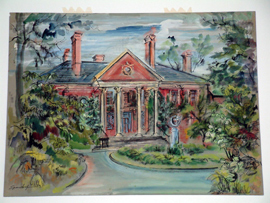
On March 20, 1962, senators attended a preview screening of Preminger's Advise and Consent at Washington's Trans-Lux Theater. The film became a box office success, but senators offered predictably mixed reviews. "Many thought it was 'good theater,' but . . . they seemed to agree they were not quite looking into a mirror," the New York Times reported. "We're much more complicated than that," Minnesota senator Eugene McCarthy complained. His fellow Minnesotan, Hubert Humphrey, added, "It was good theatre and good drama. If anyone wants a totally accurate reflection of the Senate, he can ask for a newsreel."9
Although it was a thrilling experience, the filming of Advise and Consent proved to be the last time a motion picture production crew was allowed largely uninhibited access to Senate spaces. The disruption of Senate work and other ongoing distractions prompted the Senate to refuse subsequent requests and eventually adopt rules that restrict filming and prohibit commercial use of Senate spaces unless authorized by resolution. Nevertheless, the movie captured a unique moment in time. Today, it serves as a mid-20th century time capsule of Senate history, illustrating through Preminger’s carefully constructed and edited video footage what life was like on Capitol Hill in the 1960s.10
Notes
3. Smith, “Senators Won't Be in the Show, But Their Aides Will Be.”; Betty Beale, "Capitalites Play Themselves in Film," Evening Star (Washington, D.C.), September 22, 1961, C-4; Eugene Archer Washington, "Cinema Congress: Capitol Sites, Sounds Serve 'Advise' Film," Washington Post, October 1, 1961, X7.